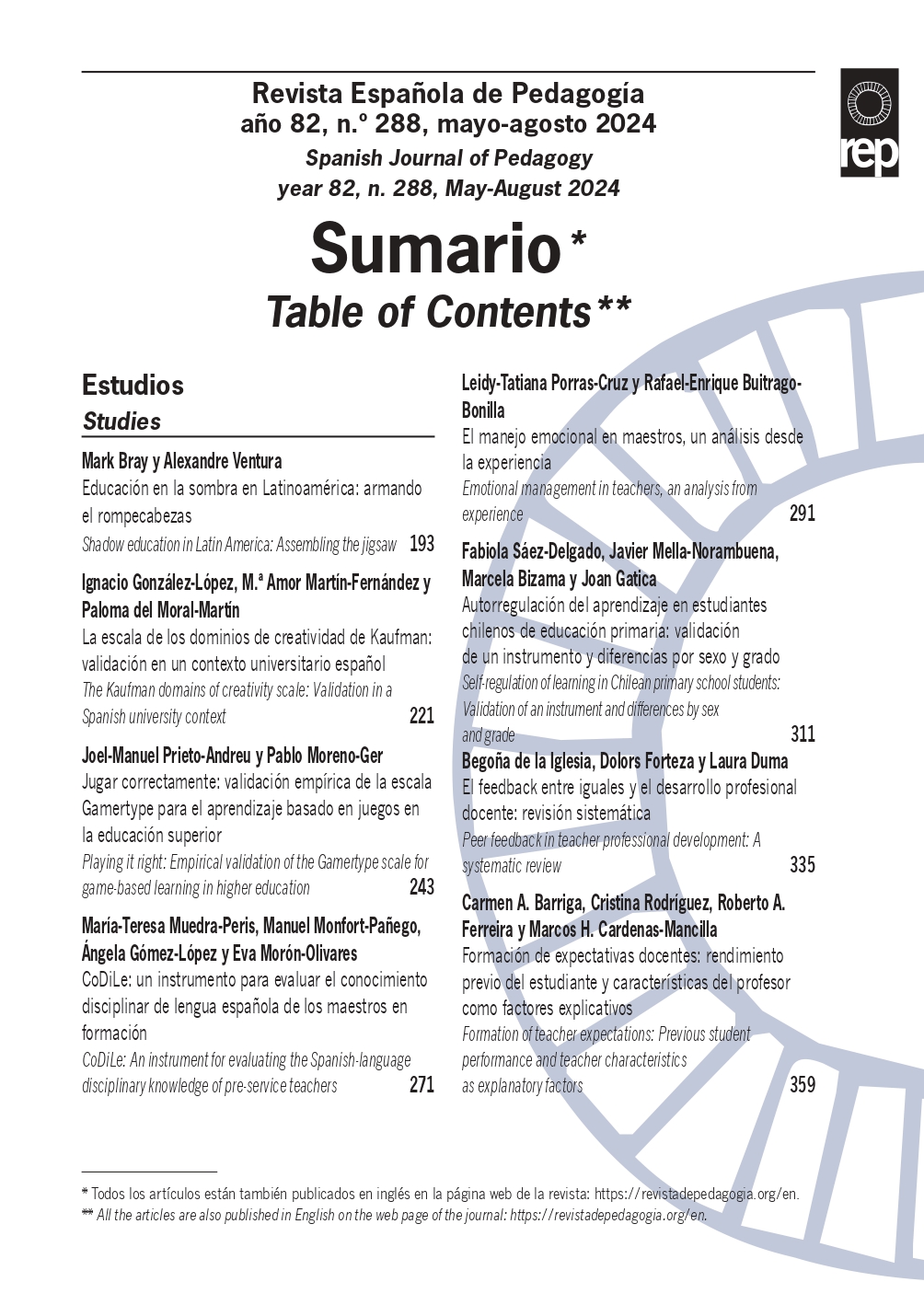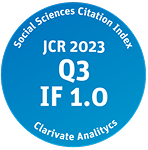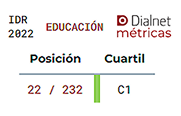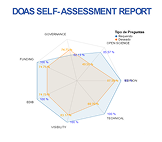The Kaufman domains of creativity scale: Validation in a Spanish university context.
DOI:
https://doi.org/10.22550/2174-0909.4041Keywords:
creativity domains, reliability, validity, factor analysis, Spanish university studentsAbstract
Understanding creativity as a set of defining elements of the creative person and giving international scientific relevance to its establishment through Kaufman’s Creativity Domains Scale, this work ensures the applicability of this instrument in a Spanish university context, after professionally translating its 50 elements into Spanish and conducting an empirical study that establishes its reliability and validity guarantees in this scenario. The analytical exploration of the constituent factors of the tool has restructured the original five domains (everyday, performance, academic, mechanical/scientific, and artistic) into eight (everyday, performance, mechanical/scientific, academic, artistic expression, artistic understanding, emotional, and mathematical). It has been revealed that students give robustness, in line with other international settings, to basic social skills, artistic competencies, scientific design strategies, and intellectual capacities that remain unquestionable within the creativity construct regardless of the population group being studied. However, the differential nuance lies in the artistic domain, which has undergone a division that gives relevance to both artistic expression and its understanding, as well as the extraction of an emotional component beyond the everyday and a purely mathematical domain disaggregated from the mechanical/scientific domain.
Downloads
References
Aranguren, M., y Irrazabal, N. (2012). Diseño de una escala para la evaluación del comportamiento creativo en diferentes dominios. Ciencias Psicológicas, 6 (1), 29-41. https://doi.org/10.22235/cp.v6i1.60
Awofala, A. O., y Fatade, A. O. (2017). Validación de una escala sobre dominios de creatividad para futuros profesores de ciencias naturales, tecnología y matemáticas. Electronic Journal of Research in Education Psychology, 13 (35), 131- 150. https://doi.org/10.14204/ejrep.35.14057
Baer, J. (2011). Domains of creativity [Dominios de la creatividad]. En M. Runco y S. Pritzker (Eds.), Encyclopedia of creativity [Enciclopedia de la creatividad] (pp. 377-382). Elsevier.
Batey, M. (2007). A psychometric investigation of everyday creativity [Una investigación psicométrica de la creatividad cotidiana] [Tesis Doctoral]. University College.
Beghetto, R. A., y Kaufman, J. C. (2007). Toward a broader conception of creativity: A case for mini-c creativity [Hacia una concepción más amplia de la creatividad: un caso para la creatividad mini-c]. Psychology of Aesthetics, Creativity, and the Arts, 1 (2), 73-79. https://doi.org/10.1037/1931-3896.1.2.73
Bermejo, R., y Ruiz, M. J. (2017). Los desafíos de la investigación sobre la especificidad o generalidad de la creatividad. En L. S. Almeida (Coord.), Criatividade e pensamento crítico: conceit, avaliação e desenvolvimento [Creatividad y pensamiento crítico: concepto, evaluación y desarrollo] (pp. 75-106). CERPSI.
Brauer, K., Sendatzki, R., Kaufman, J. C., y Proyer, R. T. (2022). Counting the muses in German speakers: Evaluation of the German-language translation of the Kaufman domains of creativity scales (K-DOCS) [Contar las musas en hablantes de alemán: evaluación de la traducción al alemán de las escalas de dominios de creatividad de Kaufman (K-DOCS)]. Psychological Test Adaptation and Development, 3 (1), 70-84. https://doi.org/10.1027/2698-1866/a000024
Carson, S., Peterson, J. B., y Higgins, D. M. (2005). Reliability, validity and factor structure of the creative achievement questionnaire [Fiabilidad, validez y estructura factorial del cuestionario de logro creativo]. Creativity Research Journal, 17 (1), 37-50. https://doi.org/10.1207/s15326934crj1701_4
Corbalán, J. (2008). ¿De qué se habla cuando hablamos de creatividad? Cuadernos de la Facultad de Humanidades y Ciencias Sociales, 35, 11-21.
Corbalán, F. J., Martínez, F., Donolo, D. S., Alonso, C., Tejerina, M., y Limiñana, R. M. (2003). CREA. Inteligencia creativa. Una medida cognitiva de la creatividad. TEA Ediciones.
Delgado, B., Martínez, M. C., Rodríguez, J. R., y Escortell, R. (2019). La autoeficacia académica y la inteligencia emocional como factores asociados al éxito académico de los estudiantes universitarios. Gestión de las Personas y Tecnología, 12 (35), 46-60.
Diedrich, J., Jauk, E., Silvia, P. J., Gredlein, J. M., Neubauer, A. C., y Benedek, M. (2018). Assessment of real-life creativity: The inventory of creative activities and achievements (ICAA) [Evaluación de la creatividad en la vida real: el inventario de actividades y logros creativos (ICAA)]. Psychology of Aesthetics, Creativity, and the Arts, 12 (3), 304-316. https://doi.org/10.1037/aca0000137
Elisondo, R., y Donolo, D. (2016). Construcción y análisis de las propiedades psicométricas del cuestionario de acciones creativas en población argentina. PSIENCIA. Revista Latinoamericana de Ciencia Psicológica, 8 (1), 1-21.
Elisondo, R. C., y Donolo, D. S. (2021). Cuestionario de acciones creativas: propiedades psicométricas de la versión abreviada (CAC42). Revista Evaluar, 21 (3), 81-94. https://doi.org/10.35670/1667-4545.v21.n3.36308
Faletič, L., y Avsec, A. (2019). Validation of the Slovene form of Kaufman domains of creativity scale [Validación de la versión eslovena de la escala de dominios de creatividad de Kaufman]. Psiholoska Obzorja, 28, 40-52. https://doi.org/10.20419/2019.28.499
García, E., Gil, J., y Rodríguez, G. (2000). Análisis factorial. La Muralla/Hespérides.
Gardner, H. (1994). Educación artística y desarrollo humano. Paidós Ibérica.
Gibim, Q. G., y Wechsler, S. M. (2020). Escala de perfil criativo, construção e estudos psicométricos [Escala de perfil creativo: Construcción de instrumento y estudios psicométricos]. Avaliação Psicológica, 19 (4), 382-389.
Hernández-Sampieri, R., y Mendoza, C. P. (2018). Metodología de la investigación. Las rutas cuantitativa, cualitativa y mixta. McGraw-Hill.
Hocevar, D. (1979, 16-19 de abril). The development of the creative behavior inventory (CBI) [El desarrollo del inventario de comportamiento creativo (CBI)] [ponencia]. Annual meeting of the Rocky Mountain Psychological Association, Las Vegas (EE. UU.).
Huang, P.-S., Peng, Sh.-L., Chen, H.-Ch., Tseng, L.- Ch., y Hsu, L.-Ch. (2017). The relative influences of domain knowledge and domain-general divergent thinking on scientific creativity and mathematical creativity [Las influencias relativas del conocimiento del dominio y del pensamiento divergente general del dominio sobre la creatividad científica y la creatividad matemática]. Thinking Skills and Creativity, 25, 1-9. https://doi.org/10.1016/j.tsc.2017.06.001
Ivcevic, Z. (2007). Artistic and everyday creativity: An act-frequency approach [Creatividad artística y cotidiana: un enfoque basado en la frecuencia de los actos]. Journal of Creative Behavior, 41 (4), 271-290. https://doi.org/10.1002/j.2162-6057.2007.tb01074.x
Ivcevic, Z., y Mayer, J. D. (2009). Mapping dimensions of creativity in the life-space [Dimensiones de la creatividad en el espacio vital]. Creativity Research Journal, 21 (2-3), 152-165. https://doi.org/10.1080/10400410902855259
Julmi, C., y Scherm, E. (2016). Measuring the domain-specificity of creativity [Medición de la especificidad de dominio de la creatividad]. University of Hagen. https://www.fernuni-hagen.de/wirtschaftswissenschaft/download/beitraege/db-502.pdf
Kandemir, M. A., y Kaufman, J. C. (2020). The Kaufman domains of creativity scale: Turkish validation and relationship to academic major [La escala de dominios de creatividad de Kaufman: validación turca y relación con la especialización académica]. Journal of Creative Behavior, 54 (4), 1002-1012. https://doi.org/10.1002/jocb.428
Kapoor, H., Reiter-Palmon, R., y Kaufman, J..C (2021). Norming the muses: Establishing the psychometric properties of the Kaufman domains of creativity scale [Regular las musas: establecer las propiedades psicométricas de la escala de dominios de creatividad de Kaufman]. Revista de Evaluación Psicoeducativa, 39 (6), 680-693. https://doi.org/10.1177/07342829211008334
Karwowski, M., y Beghetto, R. A. (2019). Creative behavior as agentic action [El comportamiento creativo como acción agéntica]. Psychology of Aesthetics, Creativity, and the Arts, 13 (4), 402-415. https://doi.org/10.1037/aca0000190
Kaufman, J. C. (2012). Counting the muses: Development of the Kaufman domains of creativity scale (K-DOCS) [Contar las musas: desarrollo de la escala de dominios de creatividad de Kaufman (K-DOCS)]. Psychology of Aesthetics, Creativity, and the Arts, 6 (4), 298-308. https://doi.org/10.1037/a0029751
Kaufman, J. C., y Baer, J. (2004). Sure, I’m creative but not in mathematics! Self-reported creativity in diverse domains [Claro que soy creativo, ¡pero no en matemáticas! Creatividad autodeclarada en diversos ámbitos]. Empirical Studies of the Arts, 22 (2), 143-155. https://doi.org/10.2190/26HQ-VHE8-GTLN-BJJM
Kaufman, J. C., y Baer, J. (2005). The amusement park theory of creativity [La teoría de la creatividad del parque de atracciones]. En J. C. Kaufman, y J. Baer (Eds.), Creativity across domains: Faces of the muse [Creatividad en todos los ámbitos: Las caras de la musa] (pp. 321-328). Erlbaum.
Kaufman, J. C., y Beghetto, R. A. (2009). Beyond big and little: The four C model of creativity [Más allá de lo grande y lo pequeño: el modelo de las cuatro C de la creatividad]. Review of General Psychology, 13, 1-12. https://doi.org/10.1037/a0013688
Kaufman, J. C., Cole, J. C., y Baer, J. (2009). The construct of creativity: A structural model for self-reported creativity ratings [El constructo de la creatividad: un modelo estructural para las puntuaciones de creatividad autodeclaradas]. Journal of Creative Behavior, 43 (2), 119-134. https://doi.org/10.1002/j.2162-6057.2009.tb01310.x
McKay, A. S., Karwowski, M., y Kaufman, J. C. (2017). Measuring the muses: Validating the Kaufman domains of creativity scale (K-DOCS) [Medir las musas: validación de la escala de dominios de creatividad de Kaufman (K-DOCS)]. Psychology of Aesthetics, Creativity, and the Arts, 11 (2), 216- 230. https://doi.org/10.1037/aca0000074
Miroshnik, K. G., Shcherbakova, O. V., y Kaufman, J. C. (2022). Kaufman domains of creativity scale: Relationship to occupation and measurement invariance across gender [Escala de dominios de creatividad de Kaufman: relación con la ocupación e invariabilidad de la medida en función del sexo]. Creativity Research Journal, 34 (2), 159-177. https://doi.org/10.1080/10400419.2021.1953823
Plucker, J. A., y Beghetto, R. A. (2004). Why creativity is domain general, why it looks domain specific and why the distinction does not matter [Por qué la creatividad es de dominio general, por qué parece de dominio específico y por qué la distinción no importa]. En R. J. Sternberg, E. L. Grigorenko, y J. L. Singer (Eds.), Creativity. From potential to realization [La creatividad. Del potencial a la realización] (pp. 153-168). American Psychological Association.
Romo, M., Sánchez-Ruiz, M. J., y Alfonso-Benlliure, V. (2017). Creatividad y personalidad a través de dominios: una revisión crítica. Anuario de Psicología, 47 (2), 57-69. https://doi.org/10.1016/j.anpsic.2017.04.003
Sánchez, L., Escalante, S., Martínez, A., y Zurita-Ortega, F. (2023). Inteligencia emocional en el perfil formativo y psicosocial de los estudiantes universitarios: una revisión sistemática. Educatio Siglo xxi, 41 (2), 147-164. https://doi.org/10.6018/educatio.515181
Sternberg, R. J. (2009). Domain-generality versus domain-specificity of creativity [Generalidad de dominio frente a especificidad de dominio de la creatividad.]. En P. Meusburger, J. Funke, y E. Wunder (Eds.), Milieus of creativity [Los medios de la creatividad] (pp. 25-38). Springer.
Susanto, E., Novitasari, Y., Rakhmat, C., Hidayat, A. y Wibowo, S. B. (2018). Rash model analysis of Kaufman domains of creativity scale (K-DOCS) to Indonesian students [Análisis del modelo Rash de la escala de dominios de creatividad de Kaufman (K-DOCS) para estudiantes indonesios]. Journal of Physics: conference series, 1114 (1), 012027. https://ui.adsabs.harvard.edu/link_gateway/2018JPhCS1114a2027S/doi:10.1088/1742-6596/1114/1/012027
Tu, C., Guo, J., Hatcher, R. C., y Kaufman, J. C. (2020). The relationship between emotional intelligence and domain-specific and domain-general creativity [La relación entre la inteligencia emocional y la creatividad de dominio específico y de dominio general]. The Journal of Creative Behavior, 54 (2), 337-349. https://doi.org/10.1002/jocb.369
Xu, X., Liu, W., y Pang, W. (2019). Are emotionally intelligent people more creative? A meta-analysis of the emotional intelligence-creativity link [¿Son más creativas las personas emocionalmente inteligentes? Un metaanálisis de la relación entre inteligencia emocional y creatividad]. Sustainability, 11 (21), 6123. https://doi.org/10.3390/su11216123
Downloads
Published
-
Abstract69
-
PDF (Español)35
-
PDF35
How to Cite
Issue
Section
License

This work is licensed under a Creative Commons Attribution-NonCommercial 4.0 International License.

